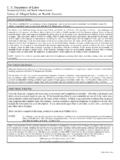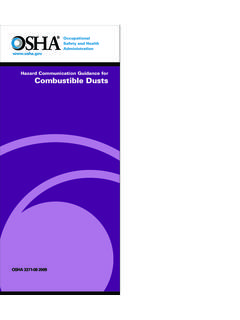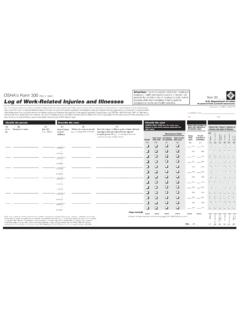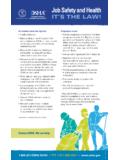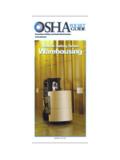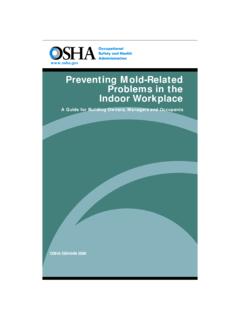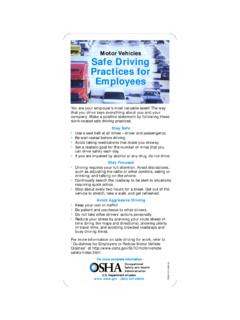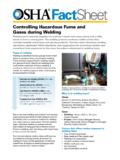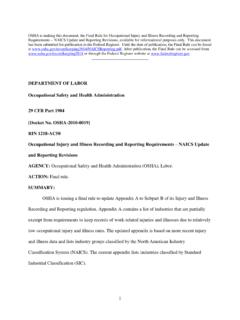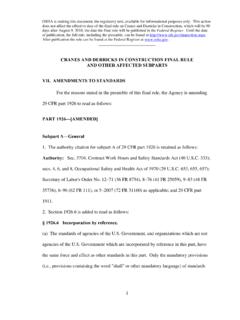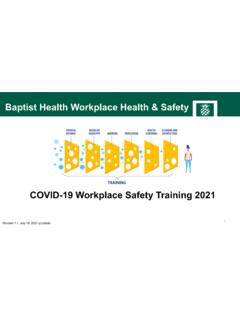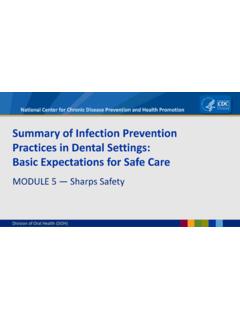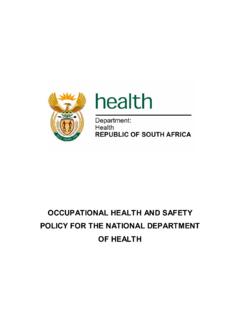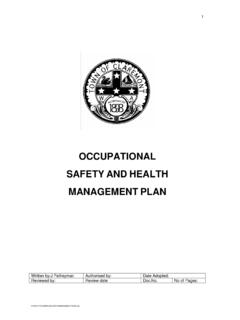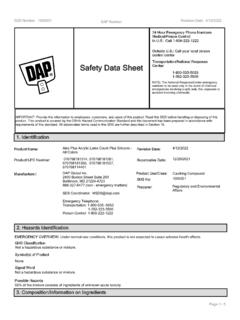Transcription of Summary: COVID-19 Healthcare ETS - Occupational Safety …
1 E M E R G E N C Y T E M P O R A R Y S T A N D A R D S U M M A R Y COVID-19 Healthcare ETS OSHA has determined that employee exposure to SARS-CoV-2, the virus that causes COVID-19 , presents a grave danger to workers in Healthcare settings where people with COVID-19 are reasonably expected to be present and has issued an Emergency Temporary Standard (ETS) to address the hazard. The virus that causes COVID-19 spreads most commonly through person-to-person contact (within about 6 feet), primarily through inhalation of respiratory particles (droplets and aerosols) produced when an infected person exhales, talks, sings, shouts, coughs, or sneezes. For the full text of the ETS, refer to 29 CFR at This Healthcare ETS applies, with some exceptions, to settings where any employee provides Healthcare services or Healthcare support services.
2 The ETS is aimed at protecting workers facing the highest COVID-19 hazards those working in Healthcare settings where suspected or confirmed COVID-19 patients are treated. This includes employees in hospitals, nursing homes, and assisted living facilities; emergency responders; home Healthcare workers; and employees in ambulatory care facilities where suspected or confirmed COVID-19 patients are treated. It does not apply to: First aid performed by an employee who is not a licensed Healthcare provider; Dispensing of prescriptions by pharmacists in retail settings; Non-hospital ambulatory care settings where all non-employees are screened prior to entry and people with suspected or confirmed COVID-19 are not permitted to enter those settings; Well-defined hospital ambulatory care settings where all employees are fully vaccinated and all non-employees are screened prior to entry and people with suspected or confirmed COVID-19 are not permitted to enter those settings; Home Healthcare settings where all employees are fully vaccinated and all non-employees are screened prior to entry and people with suspected or confirmed COVID-19 are not present.
3 Healthcare support services not performed in a Healthcare setting ( , off-site laundry, off-site medical billing); or Telehealth services performed outside of a setting where direct patient care occurs. For Healthcare settings embedded in non- Healthcare settings, the ETS applies only to the embedded Healthcare setting and not to the remainder of the physical location. Where emergency responders or other licensed Healthcare providers enter a non- Healthcare setting to provide Healthcare services, the ETS applies only to the provision of Healthcare services by that employee. The ETS exempts fully vaccinated workers from masking, distancing, and barrier requirements when in well-defined areas where there is no reasonable expectation that any person with suspected or confirmed COVID-19 will be present.
4 For more information, see the Is your workplace covered by the COVID-19 Healthcare ETS? flow chart. What are the key requirements of the ETS? COVID-19 Plan o Develop and implement a plan for each workplace (written format if more than 10 employees); o Designate workplace Safety coordinator(s), knowledgeable in infection control principles and practices, with authority to implement, monitor, and ensure compliance with the plan; o Conduct a workplace-specific hazard assessment; o Seek the input and involvement of non-managerial employees and their representatives in the hazard assessment and the development and implementation of the plan; o Monitor each workplace to ensure the ongoing effectiveness of the plan, updating it as needed; and o Include policies and procedures to minimize the risk of transmission of COVID-19 to employees.
5 Patient screening and management Limit and monitor points of entry to settings where direct patient care is provided; screen and triage patients, clients, residents, delivery people and other visitors and non-employees entering the setting for symptoms of COVID-19 ; and implement patient management strategies. Standard and Transmission-Based Precautions Develop and implement policies and procedures to adhere to Standard and Transmission-Based Precautions in accordance with CDC guidelines. Personal protective equipment (PPE) o Provide and ensure employees wear facemasks when indoors and when occupying a vehicle with other people for work purposes; o Ensure facemasks are worn over the nose and mouth. o Provide and ensure employees use respirators and other PPE for exposure to people with suspected or confirmed COVID-19 and for aerosol-generating procedures on a person with suspected or confirmed COVID-19 ; o Provide respirators and other PPE in accordance with Standard and Transmission-based Precautions; and o Allow voluntary use of respirators instead of facemasks (under the mini respiratory protection program at ).
6 Aerosol-generating procedures on persons with suspected or confirmed COVID-19 Limit employees present to only those essential; perform procedures in an airborne infection isolation room, if available; and clean and disinfect surfaces and equipment after the procedure is completed. Physical distancing Ensure each employee is separated from all other people by at least 6 feet when indoors. Physical barriers Install cleanable or disposable solid barriers at each fixed work location in non-patient care areas where each employee is not separated from other people by at least 6 feet. Cleaning and disinfection Follow standard practices for cleaning and disinfection of surfaces and equipment in accordance with CDC guidelines in patient care areas, resident rooms, and for medical devices and equipment; in all other areas, clean high-touch surfaces and equipment at least once a day and provide alcohol-based hand rub that is at least 60% alcohol or provide readily accessible handwashing facilities.
7 Ventilation Ensure that employer-owned or controlled HVAC system(s) are used in accordance with manufacturer s instructions and the design specifications of the system(s); air filters are rated Minimum Efficiency Reporting Value (MERV) 13 or higher if the system allows it; airborne infection isolation rooms are maintained and operated in accordance with their design and construction criteria; and intake ports are cleaned, maintained, and cleared of debris. health screening and medical management o Screen each employee before each work day and shift (for example, by asking employees to self-monitor); o Provide employer-required testing at no cost to the employee (Note: employers are not required to conduct screening testing); o Require each employee to promptly notify the employer when the employee is COVID-19 positive, suspected of having COVID-19 , or experiencing certain symptoms; o Notify certain employees within 24 hours when a person who has been in the workplace is COVID-19 positive; o Follow requirements for removing workers from the workplace; o Make decisions on returning employees to work in accordance with guidance from a licensed Healthcare provider or specified CDC guidance.
8 And o Continue to pay removed employees in most circumstances. Vaccination Provide reasonable time and paid leave for vaccinations and vaccine side effects. Training Ensure each employee receives training in a language and at a literacy level the employee understands so that the employee comprehends disease transmission, tasks and situations in the workplace that could result in COVID-19 infection, and relevant policies and procedures; ensure each employee receives additional training when changes occur that affect the employee s risk of infection, if policies or procedures are changed, or when there is an indication that an employee has not retained necessary understanding or skill. Anti-Retaliation Inform employees of their rights to the protections required by this standard and do not discharge or in any manner discriminate against employees for exercising these rights or for engaging in actions required by the standard.
9 Requirements must be implemented at no cost to employees Recordkeeping Establish a COVID-19 log (if more than 10 employees) of all employee instances of COVID-19 without regard to Occupational exposure and follow requirements for making records available to employees. Reporting COVID-19 fatalities and hospitalizations to OSHA Report to OSHA each work-related COVID-19 fatality within 8 hours of learning about the fatality, and each work-related COVID-19 in-patient hospitalization within 24 hours of learning about the in-patient hospitalization. Mini respiratory protection program (29 CFR ) Under certain circumstances in the ETS, and only for employees who are not exposed to suspected/confirmed sources of COVID-19 or other hazards that may require respirator use covered under the normal Respiratory Protection Standard (29 CFR ), the employer must provide training on inspecting, putting on, removing, and using respirators like N-95s; the limitations and capabilities of the respirator; procedures and schedules for storing, maintaining, and inspecting respirators; how to perform a user seal check; and how to recognize medical signs and symptoms that may limit or prevent the effective use of respirators.
10 This summary highlights some of the new requirements of the ETS; employers should consult the standard for full details. Additional Information Visit for additional information on: COVID-19 Laws and regulations COVID-19 Enforcement policies Compliance assistance materials and guidance Worker s Rights (including how/when to file a Safety and health or whistleblower complaint). The ETS is effective immediately upon publication in the Federal Register. Employers must comply with most provisions within 14 days, and with the remaining provisions within 30 days. OSHA will use its enforcement discretion to avoid citing employers who are making a good faith effort to comply with the ETS. OSHA will continue to monitor trends in COVID-19 infections and deaths as more of the workforce and the general population become vaccinated and the pandemic continues to evolve.
